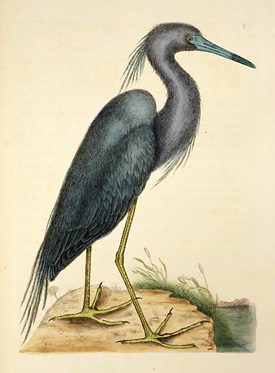The new exhibit “Discovering 18th-Century British America: The William L. Clements Library Collection” celebrates both a unique time in history, and a novel U-M collection.
It is on display through Jan. 13 at the U-M Museum of Art, next to a companion exhibit, “Benjamin West: General Wolfe and the Art of Empire.” While the “Benjamin West” exhibit focuses on artist’s depictions of the period, “Discovering 18th Century British America” presents a range of materials. They include letters, engravings maps and books from the collection assembled by Clements staff.

“Heron” by Mark Catesby. Photo courtesy of Clements Library.
The presentation of the two exhibits in the UMMA space — vastly larger than the Clements Library exhibit space — allows Clements curators to put before the public several items never before displayed.
An 1882 graduate of the university and a longtime member of the Board of Regents, William L. Clements became wealthy by designing and manufacturing heavy steam powered equipment, including railroad cranes, pile drivers and steam shovels.
“He began his collecting career as a book collector, and donated his collection to the university in 1923,” says Brian Dunnigan, Clements Library associate director, who curated the exhibit with the library’s Curator of Graphics Clayton Lewis. Dunnigan says that after Clements donated his book collection, he was introduced to historical manuscripts, and developed a new passion to collect them. “That’s what he did for most of the ’20s,” Dunnigan says.
As his interest in the British colonial era in America grew, Clements acquired seminal collections of key historical figures of the time. They included the papers of Thomas Gage, British military commander at the start of the American Revolution; the papers of William Petty, a British prime minister at the end of the Revolutionary War; and Sir Henry Clinton, a prominent British general.
“They give us a window on how the British administration functioned in America and how British military policy was conducted,” Dunnigan says. Displayed in the exhibit is a 1775 letter from Gage, a key document to the American Revolution. Responding to increased public unrest with British policies, Gage orders a commander to lead British soldiers from Boston to nearby Concord, Mass., to “seize and destroy all artillery and military stores nearby.”
Visitors to the exhibit also will see maps, prints and manuscripts by notables including Paul Revere; the 1760-61 Murray atlas of settlements along the St. Lawrence River in Canada assembled like panels in a “AAA trip-tik” format; and rare views of leading early American seaports and cities.
Noting that Clements in the 1920s paid $101,500 alone for the Gage collection, Dunnigan says it would now be tremendously expensive to assemble a comparable collection. “Many of these items are unique or held by institutions now, it would be impossible to acquire this material today,” he says.
Also on display is a letter from Rachel Revere to husband Paul, after his midnight ride to warn colonials of advancing British troops. She writes, “I send a hundred & twenty five pounds and beg you will take the best care of your self and not attempt coming in to this town again.”
The exhibition is part of the new U-M Collections Collaborations series, which is co-organized by and presented at UMMA and designed to showcase the renowned and diverse collections at the University of Michigan, says UMMA Director Joseph Rosa. The U-M Collections Collaborations series is supported by the Andrew W. Mellon Foundation.

